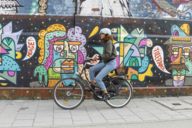
When asked where the first German graffiti originated, most people would go for Berlin Kreuzberg. But no, it was Munich. The German graffiti movement started there already back in 1970. When the puzzling inscription “Heiduk” appeared overnight on many house walls in Schwabing and Lehel, half of Munich racked its brains as to what it could mean, and gave birth to the wildest of speculations. A bike tour through Munich tracks the history of street art.
Only insiders would know where to locate the first train painted along its entire length in a tiny little place in Upper Bavaria. One cold night in March 1985, a bunch of youths crept into the regional S-Bahn train depot of Line S4 in Geltendorf and adorned a complete train with colourful caligraphy and comic-style figures. This legendary debut of the German street art scene went down in art history as the “Geltendorf Train”.
One member of the painting spree was a young man called Mathias Köhler aka Loomit, now one of Germany’s best known graffiti artists. He no longer has to creep around in the dark, but has long since immortalized himself with major works commissioned in the public domain. For instance, together with his spraying colleague Won ABC, he created a gigantic mural in the heart of Munich, dedicated to resistance fighter Johann Georg Elser.
The Museum of Urban and Contemporary Art, MUCA for short, tells the story of street art and is the first of its kind in Germany. It exhibits the works of internationally renowned graffiti artists and provides a varied programme of workshops and talks, readings and guided tours to inform the public of this fledgling art form.
The guided MUCA Street Art Bike Tour takes groups to a number of sites of the Munich graffiti scene. Those who want to discover Munich’s street art off their own bat get a bike tour map showing the MUCA Street Art Bike Tour destinations, which is also available in digital form. Due to the coronavirus and increased hygiene requirements, all participants must bring their own bikes until further notice.
Here is a little sneak preview: The tour lasts about four hours and starts at the MUCA. The first stop is the pedestrian tunnel below the Angel of Peace (Friedensengel). Graffiti artists from all over the world were invited by Loomit to brighten up the grey walls with colourful pictures. The route continues along the cycle path running alongside the Isar River to secret places, tunnels and subways that are not in every city guide.
Another highlight of the tour is the “Bridge Gallery” at Candidplatz. Eighteen artists have turned the mighty pillars of the Candidbrücke (bridge) into a true picture gallery. One of the participants was Case, one of the most famous street artists in the world. And not to be missed of course is the “Hall of Fame” at the old Viehhof (cattle yard) near the containers of the alternative cultural centre “Bahnwärter Thiel”. The round trip terminates at the MUCA with a guided tour of the current exhibition entitled “Urban Fine Art II” showing originals by Banksy, Kaws, Shepard Fairey, Swoon and many other renowned artists.
Usually street art is not made to last an eternity; much of it is sprayed over again or at some time or other falls victim to the demolition ball. The cranes are also already in action at the “Schlachthofviertel”, announcing the erection of new building projects. One particular feature of the lively Munich street art scene, which is also supported by the city’s Department of Arts and Culture, is its concentration on cultural hot spots.